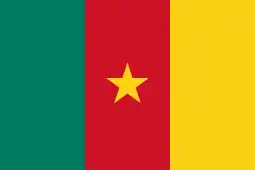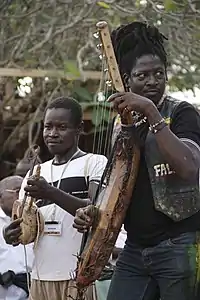Culture of Cameroon
Cameroon has a rich and diverse culture made up of a mix of about 250 indigenous populations and just as many languages and customs. The country is nicknamed "Little Africa" as geographically, Cameroon consists of coastline, mountains, grass plains, forest, rainforest and desert, all of the geographical regions in Africa in one country. This also contributes to its cultural diversity as ways of life and traditional food dishes and traditions vary from geographical region to geographical region.
| Part of a series on the |
| Culture of Cameroon |
|---|
 |
| History |
| People |
| Languages |
| Cuisine |
| Religion |
| Art |
| Literature |
| Sport |
|
Holidays
Religious holidays in Cameroon include:
- Christian: Good Friday, Easter Sunday, Easter Monday, Pentecost, Ascension Thursday and Palm Sunday
- Muslim: Eid ul-Fitr, Eid ul-Adha and Ramadan
Politics
Since an amendment was added to the Cameroon Constitution in 1992, Cameroon has been a multi-party state, which means there are multiple parties that have the potential to gain power over the government. Cameroon's first president, Ahmadou Ahidjo, was in power from 1960 to 1982.[1] The president holds executive power for seven years, for a maximum of two terms. The president and his cabinet hold the main power at the national level, while at the local level, the prefet and sous-prefet hold the most power. Getting a government position can happen several different ways: Regional background, ethical background, party loyalty, and who you know. The national and local levels have been known to work together, even though they have to deal with their own separate issues from each other.[2]
Religion
Cameroon culture consists of numerous religions including Christianity (about 69%), Islam (about 21%), and many other indigenous religions. The citizens of Cameroon are entitled to freedom of religion, as it is stated within their constitution. Therefore, citizens are free to practice any religion they choose, without harassment or forceful conversion. The northern part of Cameroon is heavily occupied by the Fulani people (Fula: Fulɓe; French: Peul or Peulh; also known Mbororo, though this is sometimes seen as pejorative). The Fulani are mainly Muslims, because Islam is the dominant religion in the northern region. The western region is home of the Bamum people, an ethnic group that also practices the Islamic religion. The French-speaking people are often inhabitants of the southern and western regions and the majority of them are known to be Catholic, while English speaking citizens of the west tend to be Protestants.
Fashion

Cameroon's relatively large and diverse population is also diverse with respect to its contemporary fashion. Climate, religious, ethnic and cultural belief systems as well as influences from colonialism, imperialism and globalization are all reflected in the clothes worn by modern Cameroonians.
Notable Cameroonian articles of clothing include: Pagnes, a sarongs worn by Cameroon women, Chechia, a traditional hat, Kwa, a male handbag and Gandura, male custom attire.[3] Wrappers and loincloths are used extensively by both women and men but their use varies by region with influences from Fulani styles more present in the north and Igbo and Yoruba styles in the south and west. [4]
Imane Ayissi is one of Cameroon's top fashion designers and has received international recognition.[5]
Culture and traditions


Cameroon has 250-300 distinct groups, and an estimated 300+ languages. [6] These languages include the Akoose language, the Gbaya languages, the Fula language, the Gyele language, the Koonzime language, the Mundang language, the Ngiemboon language, and the Vengo language.[7] Others include Ewondo, Bassa, Bamileke, Duala and Arabic in the North and Far-North regions.
Cameroon is divided into several provinces, which are dominated by specific ethnic or religious groups. Ethnic divisions often correspond to geography, which is also widely varied. Religious differences often correspond to colonial or other historical influence.[8]
Partly through the influence of colonialism, there is a national culture, and two distinct regional cultures: the Anglophone and Francophone regions, which primarily speak English and French and use different legal systems. The national culture is established through public institutions such as school, the multiparty political system, shared history of colonialism and a national love of football.[9]
Theatre of Cameroon is also another important aspect of local culture.
Media
Gallery
South
North
North-West
West
Littoral
East
Centre
South
North















 Danse Tupuri
Danse Tupuri Dance Group
Dance Group Tam-tam player
Tam-tam player
North-West

















 Joueur de guitare
Joueur de guitare
South-West
Littoral
East



 Joueur de Tam-tam
Joueur de Tam-tam
West



 Tam-Tam player
Tam-Tam player

 Group of Tam-tam players
Group of Tam-tam players
South




 Mvet
Mvet
North










 Tam-tam
Tam-tam Guitar
Guitar

North-West











 Flute
Flute Sanza
Sanza Tam-tam
Tam-tam Guitar
Guitar Another guitar
Another guitar
Littoral
East
West
 Bamileke cowbells
Bamileke cowbells Balafon
Balafon Another balafon
Another balafon Tam-tam
Tam-tam Sanza
Sanza Sanza
Sanza Balafon
Balafon Balafon
Balafon

See also
- Cameroon
- Cuisine of Cameroon
- Languages of Cameroon
- Music of Cameroon
- List of writers from Cameroon
References
- "Ahmadou Ahidjo". Encyclopædia Britannica.
- "Culture of Cameroon - history, people, clothing, traditions, women, beliefs, food, customs, family". everyculture.com.
- "Cameroon clothing - A description of the traditional attire of Cameroon". Cameroon-Today.com. Retrieved Jul 23, 2020.
- Culture and Customs of Cameroon, 2000, pg. 135, by, John Mukum Mbaku
- "Cameroon:Imane Ayissi detremined to project Cameroon's couture". Journal du Cameroun (in French). July 4, 2020.
- Archived copy from the Ethnologue Database website, archived from the original on 2006-07-11, retrieved 2006-07-12
- "Language of Cameroon: Cameroon language & listing of all Cameroon main languages". Cameroon-Today.com.
- Cameroon. New Encyclopedia of Africa. Ed. John Middleton and Joseph C. Miller. Vol. 1. 2nd ed. Detroit: Charles Scribner's Sons, 2008. p298-307.Word Count:4863.
- Cameroon. PAMELA FELDMAN-SAVELSBERG. Countries and Their Cultures. Ed. Carol R. Ember and Melvin Ember. Vol. 1. New York: Macmillan Reference USA, 2001. p384-396.Word Count:5376.
Further reading
- "Revue Noire" - Special Issue on Cameroon, n. 13, 1994.
- Cameroun: la culture sacrifiée. Dossier of the magazine "Africultures", n. 60, L'Harmattan, July–September 2004.
External links
 Media related to Culture of Cameroon at Wikimedia Commons
Media related to Culture of Cameroon at Wikimedia Commons- The portal of Cameroon on the SPLA Sud Planète database managed by Africultures KAMERCULTURES

































































